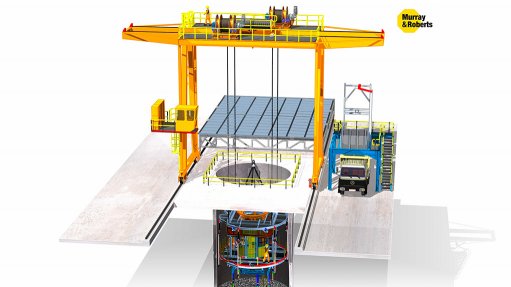
CONTINENTAL FIRST Murray & Roberts Cementation designed a compact gantry system for pre-shaft sinking in the mining industry
South African construction group Murray & Roberts Cementation has developed a pre-shaft sinking system – the first of its kind in Africa – which will be used at a mine site early next year.
The pre-shaft sinking system, also known as the gantry system, was designed and engineered over the past nine months using expansions and reconfigurations of shaft- sinking technologies applied during construction of the Gautrain, Murray & Roberts Cementation business development director Allan Widlake tells Mining Weekly.
“Murray & Roberts Cementation, which offers several mine services, including vertical and decline shaft sinking and equipping, designed and engineered what we believe is an ideal solution for pre-shaft sinking,” he says, adding that this system comprises a moving gantry on which the lifting devices' stage and kibble winder are mounted.
The gantry is structured on two tracks, which allows for easy positioning of the system over the shaft collar, Widlake says. The lifting devices, mounted on the gantry, can raise and lower the suspended stage – on which shaft-sinking operations are carried out – and separately raise and lower the kibble into the shaft for men, material and rock hoisting.
The kibble can cross to both ends of the gantry, either to drop off the mineworkers at one end or to unload rock directly onto the trucks at the opposite end. Widlake says the system’s lifting devices conform to all the mining legal requirements for such devices.
“The whole unit is designed to be significantly compact and to perform all functions, such as lifting the kibble, and con- trolling and moving all the shutters, while the main operator, sitting in an elevated position, can monitor the entire operation,” he adds.
In comparing the new system with traditional systems, Widlake notes that traditional pre-shaft sinking systems comprise either the Scott Derrick system entailing a fixed crane mounted on a con- crete block, with a hoisting jib crane that allows for limited and restricted lifting capacity of about six tonnes from the bottom of the shaft, or mobile cranes that generate significant mobilisation and operational costs.
Widlake highlights that the gantry system has been designed to handle a main lifting capacity of 25 t from the bottom of the shaft at any time.
Other advantages include the system’s mobility, as the operations crew can also move the gantry system away from the shaft during blasting to prevent possible damage, and roll it back over the shaft after blasting to start the cleaning operation.
Further, the system requires about 30% fewer crew members to manage it, Widlake notes.
“We hope that the gantry system sets the benchmark for future pre-shaft sinking, owing to the safety outcomes and the enhanced productivity . . . during this specific phase of mining projects,” he adds.
Trial Run
The system is undergoing trial runs at Murray & Roberts Cemen- tation’s training academy and testing facility in Bentley Park, near Carletonville, in Gauteng.
Trials started in July and the system will be subjected to multiple tests before it will be moved to its mine site.
“Murray & Roberts Cementation is preparing all the procedures for the system’s operations while also training the crews that will manage the system,” Widlake says.
He adds that the mine is preparing the foundations and tracks for the unit, as well as the collar of the shaft. The gantry system will sink two shafts for the mine.
Another key objective is to resolve any issues beforehand at the training centre. This will result in Murray & Roberts Cementation fulfilling its intention for the fully operational system to immediately achieve the required productivity rate, Widlake points out.
Previous pre-shaft sinking systems required multiple pieces of equipment. Widlake emphasises that “industry will appreciate the entire shaft-sinking concept being wrapped into a single unit”, as the system will function on the ‘plug-and-play’ principle, basically requiring only a set of tracks to run on and no other significant foundations.
Although the system is designed for the pre-sinking of shafts, Widlake says it can be used in the mining and civil sectors.